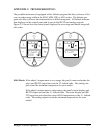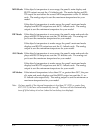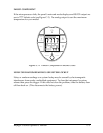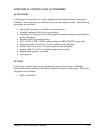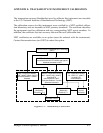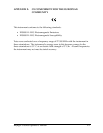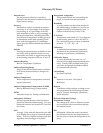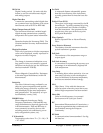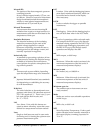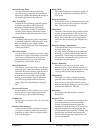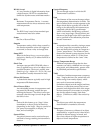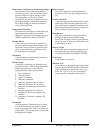
Glossary-4 Raynger 3i Series Operator's Manual
Neutral Density Filter
An optical element used to restrict the
amount of energy reaching an instrument’s
detector by ideally attenuating the energy at
all wavelengths by the same amount.
NIST Traceability
Calibration in accordance with and against
standards traceable to NIST (National
Institute of Standards and Technology,
USA). Traceability to NIST is a means of
ensuring that reference standards remain
valid and their calibration remains current.
Non-Gray Body
A radiating object that is partly transparent
to infrared (transmits infrared energy at cer-
tain wavelengths); also called Colored
Bodies. Glass and plastic films are examples
of non-gray bodies.
Optical Pyrometer
A system that, by comparing a source whose
temperature is to be measured to a standard-
ized source of illumination (usually com-
pared to the human eye), determines the
temperature of the former source.
Optical Resolution
The distance to size ratio (D:S) of the IR mea-
surement spot, where the distance is usually
defined at the focus distance, and the size is
defined by the diameter of the IR energy
spot at the focus (typically at the 90% IR
energy spot diameter). Optical resolution
may also be specified for the far field by
using values of far field distance and spot
size.
Pyroelectric Detector
Infrared detector which behaves as a current
source with an output proportional to the
rate of change of the incident IR energy.
°R (Rankine)
Temperature scale where °R = 1.8 x K, or also
°R=°F+460.
Radiation Thermometer
A device that calculates an object’s tempera-
ture (given a known emissivity) from mea-
surement of either visible or infrared radia-
tion from that object.
Recall (RCL)
When the Recall loop is activated, stored val-
ues can be recalled from either the RUN or
LOG loops.
Reference Junction
Refers to the “cold” or ambient thermocouple
junction, which is held at a known tempera-
ture. Also see thermocouple.
Reflectance
The ratio of the radiant energy reflected off a
surface to that incident on the surface; for a
gray body this is equal to unity minus emit-
tance; for a perfect mirror this approaches
unity; and for a blackbody the reflectance is
zero.
Reflected Energy Compensation
Correction feature used to achieve greater
accuracy when, due
to a high uniform background temperature,
IR energy is reflected off the target into the
instrument. If the background temperature
is known the instrument reading can be cor-
rected by using this feature.
Relative Humidity
The ratio, expressed as a percent, of the
amount of water vapor actually present in a
sample of air to the greatest amount of water
vapor possible at the same temperature.
Repeatability
The degree to which a single instrument
gives the same reading on the same object
over successive measures under the same
ambient and target conditions (per the ASTM
standard test method E 1256-88).
Resolution
See Temperature Resolution or Optical
Resolution.
Response Time
A measure of an instrument’s change of out-
put corresponding to an instantaneous
change in target temperature, generally
expressed in milli-seconds, for 95 percent of
full scale temperature indication (per the
ASTM standard test method E 1256-88). The
specification for Raytek instruments also
includes the average time required for soft-
ware computations.



